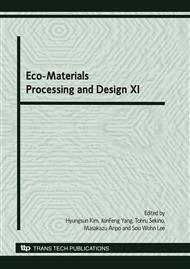p.177
p.181
p.185
p.189
p.193
p.197
p.201
p.207
p.211
Dynamic Compression Behavior of Lotus-Type Porous Iron
Abstract:
Dynamic and quasi-static compression tests were conducted on lotus-type porous iron with porosity of about 50% using the split Hopkinson pressure bar method and universal testing machine, respectively. In the dynamic compression parallel to the pore direction, a plateau stress region appears where deformation proceeds at nearly constant stress, while the plateau stress region does not appear in the quasi-static compression. The plateau stress region is probably caused by the buckling deformation of matrix iron which occurs only in the dynamic compression. In contrast, the compression perpendicular to the orientation direction of pores exhibits no plateau-stress regions in the both dynamic and quasi-static compression.
Info:
Periodical:
Pages:
193-196
Citation:
Online since:
July 2010
Keywords:
Price:
Сopyright:
© 2010 Trans Tech Publications Ltd. All Rights Reserved
Share:
Citation:


